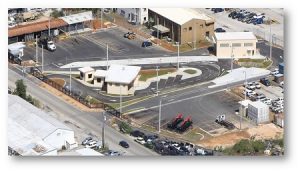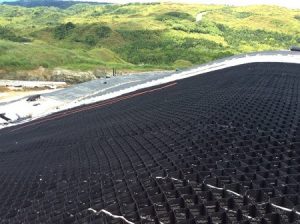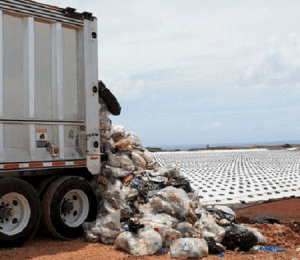Feature facilities and a management system from non-integrated and unsustainable were transformed to an integrated and sustainable path with a state-of-the-art landfill, dump closure system, leachate management, residential transfer stations, and a revamped waste management collection program that will service the island for at least another 40 years.
Christopher Lund, PE
As the entrance gate rolled smoothly open for the first time on January 23, 2015, a residential customer made use of the first permanent Household Hazardous Waste facility constructed on Guam. With great fanfare and celebration, the new Harmon Residential Transfer Station opened to serve the island community with the ability to receive household hazardous waste (HHW), residential waste, and recyclables. Another first time event occurred only a week later on January 30, 2015, when leachate collection began at the island’s 341-foot mountain of waste, Ordot Dump, that had been allowed to discharge leachate uncontrolled for over 70 years into the environment. That leachate now is being sent to be treated at a wastewater treatment plan, and the dump closed with a state-of-the-art, environmentally sound closure system.
These two milestones continue the marked progress and complete reversal for waste management in the U.S. Territory of Guam. A process that has taken the island’s 70-year history of unsustainable, inefficient and environmentally unsound solid waste management practices into an integrated sustainable management path, not only with the opening of the new residential transfer and HHW facility, and leachate control at the dump, but also with financial and solid waste collection management control and improvements. How these capital improvements and management changes are occurring and promising sustainability for the future are the continuing lessons offered in this article.




How Guam Got Here
Briefly:
- 1940s—Ordot Dump began as a dumping ground for the U.S. Military, Guam’s industrial and municipal solid waste, and was used by the Japanese and U.S. Military forces during World War II
- 1950—Ordot Dump ownership was transferred to the Government of Guam from the U.S. Government and since the 1950s used continuously as an uncontrolled and unlined facility with regular waste fires into the late 2000s. With sloping topography and shallow bedrock, stormwater filtered through the waste, picking up pollutants, and exited the dump pile, streaming into the nearby Lonfit River and discharging into the coral reefs of Pago Bay.
- 1990—U.S. EPA Administrative Order directed the cessation leachate discharge from the dump.
- 2004—U.S. District Court of Guam approved a Consent Decree (Civil Case No. 02-00022), in which the Government of Guam agreed, among other provisions, to cease the discharge of pollutants from the Ordot Dump, close the Ordot Dump within 45 months and begin implementation of a post-closure plan. In addition, DPW agreed to site, obtain permits for, construct and begin operations of a new municipal sanitary waste landfill within 44 months.
- 2008—After failure by the Government of Guam to comply with the Consent Decree, Chief Judge Frances Tydingco-Gatewood of the District Court of Guam, appointed Gershman, Brickner & Bratton, Inc. (GBB) (Fairfax, VA) as Court Receiver with full authority to manage, supervise and oversee the Government of Guam’s compliance with the Consent Decree. To accomplish this end, the Court took the unprecedented step in putting the Solid Waste Management Division (SWMD) of the Guam Department of Public Works under the complete management and supervision of GBB to bring Guam into compliance with the Consent Decree.
How Far to Go? An Unsustainable Solid Waste Management System
As was described in the article, “180° Turnaround for a Solid Waste Management System: The Guam Story and Lessons Learned” (Waste Advantage Magazine, February 2012), when GBB staff arrived in 2008 to take over management of the SWMD, they found a solid waste management system plagued by decrepit facilities, unknown environmental issues, and serious operational, financial and administrative problems—essentially a mess from top to bottom. The SWMD only picked up residential solid waste.
The Dump was discharging leachate daily into the nearby river with no pretreatment, not even through a stormwater management pond. Improper daily cover, a coralline sandy gravel, was being used. There was no gas and groundwater monitoring, let alone gas collection. Residents of the nearest house—300 feet downwind from active operations—and other Dump neighbors complained of odors and garbage fires at the Dump. There was no scale to accurately calculate the tonnage of waste disposed there. The island also had no recycling program, and no efforts were being made to divert HHW and other waste to extend the dump’s diminishing capacity.
Most facilities had not been renovated since being built more than 25 years ago—suffering through multiple typhoons (Guam is in the path of the Pacific ‘Typhoon Alley’) and earthquake events (Guam is Earthquake Zone 4), weakening the structures. Staff were not supplied adequate tools and systems with which to work, electrical systems were faulty, computers systems were outdated and at risk, and staff morale was at an all-time low. The costs for use of rental equipment and equipment, long since depreciated, could not be sustained. Without a reliable billing and account management system, SWMD could not adequately plan for future needs and establish reserve accounts. In short, Guam’s solid waste system was unintegrated and unsustainable.
Every day challenges continue to present themselves. The Receiver needed to work with the Government of Guam agencies, and its SWMD to achieve full compliance with the 2004 Consent Decree by opening a new landfill; fully investigating, designing, and closure construction of the Dump; implementing a post-closure plan at the Dump; and obtaining federal and local permits for field investigations, construction, operation, and compliance monitoring of a new municipal solid waste landfill, Dump, residential transfer stations and HHW facility. The Receiver continued to face additional challenges, including changes in legal counsel, challenges by the Government of Guam to repurpose priorities for Consent Decree Bond Funding to pay for landfill land acquisition, Appeals Court challenges, and legal maneuvers with media campaigns to thwart the Court’s orders and renege on Consent Decree commitments. The Receivership has been in a race against time. So, how has the solid waste management system been turned around to become sustainable and integrated?
Road to a Sustainable System
The Receiver multi-disciplinary team of solid waste, procurement, landfill, engineering, financial and communications staff presented to the District Court of Guam a road map for accomplishing the Consent Decree projects and reforming Guam’s solid waste management system. Chief among the initial steps and objectives were:
- Improve customer service
- Establish financial accountability
- Reduce costs through operational efficiencies
- Establish long-term financing
- Preserve and extend disposal space
Seven years after the appointment of the Receiver, a visit to the GSWA1 facilities and Guam’s neighborhoods present dramatic signs of the integration that has taken place. The GSWA’s 17,000 customers each have a two 95-gallon carts—one for trash and the other for recyclables. Recyclables are collected twice a month (paper, aluminum, metal cans, and plastic) at curbside, which has diverted waste volumes to be landfilled and has reduced the cost of managing that waste. The recycled program cost per ton is $129 compared with the waste disposal program cost per ton at $171. Implicit in the curbside collection of recyclables is the reduction in roadway traffic and fuel costs for those who took their waste to recycling convenience centers before curbside collection began. The processing of recyclables has also generated jobs in the local economy. To support the single-stream recycling program, the operator of the commercial transfer station installed a multi-sort line in 2013 to separate recyclables for packaging and shipment off island for processing.
GBB has also integrated the collection of bulky waste, with two free pickups per year for residential customers, $25 for each additional pickup. This has generated 1,363 pickups collecting 3,994 bulky items in 2014. A concurrent sign of sustainable change, the GSWA reduced staff from 99 to 54 by June 2011. While adding curbside recycling and opening a new residential transfer station, GSWA has added just two additional full-time, to a total of 56, by December 2014 (see Integration Sidebar, page xx).
Another sign of improvement in performance sustainability is the continued high level (99.7 percent) of trash collections that are now made on time, in part due to new trucks and reliable equipment and a motivated work force. With the GSWA’s new billing and customer service system, RFID tags on trash carts and policies to ensure that only paying customers receive service; the number of delinquent residential accounts declined from 15 percent in September 2010 to 1.8 percent in December 2014. The cash position of GSWA has improved dramatically from a negative position of -$200,000 in 2009, to +$14,500,000 in December 2014. GSWA now has reserve accounts for landfill closure, new cell development, and post-closure care with sustainable funding generated from revenue collected at nearly 100 percent rate of the revenue billed.
The Receiver’s Work Continues to Transition
The Receiver’s work continues beyond the opening of the Household Hazardous Waste facility and ceasing leachate discharges at the Dump. Transition of the operations and management for GSWA must revert from the Receiver back to the Government of Guam. Staff has assisted the Government of Guam in establishing the GSWA Board of Director functions with monthly meeting support and reporting of GSWA operations to familiarize the new Board members with the Authority’s financial and operational management. The Board is developing board policies and procedures, has hired board counsel and is in the process of initiating a General Manager personnel search. Staff is now in the final year of the two-year closure construction effort to installation the geosynthetic cover on the Ordot Dump, which will collect greenhouse gases for the first time, divert clean stormwater, and provide groundwater and gas monitoring for the next 30 years. In addition, GBB will procure a post-closure care operator and provide technical and environmental compliance monitoring support. In the operations area, three residential transfer stations will be renovated to bring them into compliance with regulatory standards, and continue to implement the household hazardous waste program on the island. The Receiver also continues its oversight of the Government of Guam – Department of Public Works to ensure road project commitments made for the landfill haul road are followed through so that road hazards are mitigated.
Guam’s residents now have a more integrated and sustainable solid waste management system that will serve them well with waste diversion, curbside recycling, household hazardous waste program, a modern landfill and a soon-to-be environmentally closed Dump that no longer pollutes the environment as it did for 70 years. A January 21, 2015, a Marianas Variety article stated, “As the Guam Solid Waste Authority prepares to open the Harmon Hazardous Waste and Solid Waste Transfer Facility, we offer our kudos to those responsible for Friday’s opening and for the overall progress in the island’s solid waste disposal system. Those kudos go to the U.S. District Court of Guam … Fortunately, the court appointed a receiver with the experience and competence to turn the solid waste system around. The unreliability and inefficiencies of seven years ago have faded.”
Christopher Lund is a Senior Vice President and Owner of Gershman, Brickner & Bratton, Inc. as well as the Guam Solid Waste Receiver Project Engineering Manager for the U.S. Territory of Guam, Guam Solid Waste Authority. He can be reached at [email protected].
Note
- Through legislation, the Government of Guam took a big step forward in 2011. Public Law 31-20 creating the GSWA, an autonomous, public corporation, became law on April 4, 2011. The legislation established an agency to handle the operations of what was formerly the Solid Waste Management Division, under the Department of Public Works.
Sidebar
Unsustainable Facilities and Operations by the Numbers
- 45- acre Ordot dump (Dump) being used daily for disposal of approximately 280 tons per day of MSW—running out of space in less than three months
- Dump had zero stormwater management facilities
- Annual average of 100 inches of rain was allowed to filter through the waste, generating leachate
- 55,000,000 million gallons annual percolation through the dump, peak daily discharge 600,000 gallons
- Three residential transfer stations—not permitted with unknown environmental issues
- One collection truck operating to service 12,000 customers
- $11,000 per day in rental equipment and contact operators
- Billing system unreliable and unchecked, no scale at dump or anywhere on island
- 4,000 customers not being billed at all
- Most office and employee facilities in un-useable and unsafe conditions
- No residential bulky waste or recyclable collection offered
- No regular HHW collections or permanent facility to handle
- Revenues did not support operational costs
- No reserve accounts established to provide funding for operational equipment, closure, or future landfill space.
Sidebar
Integration and Sustainable Reforms
Operational
- Initiated waste diversion with the integration of curbside single-stream recycling services
- Contracted a multi-sort line for single-stream recycling to be established at the transfer station
- Initiated curbside bulky waste collection services for residential customers
- Added Residential Transfer Station and Household Hazardous Waste Collection Facility
- Repaired vehicles and purchased new equipment to support operational needs
- Added only two employees while substantial services were added (new Residential Transfer Station/HHW Facility, Recycling and Bulky Waste Collection)
- Dramatically improved working facilities for GSWA employees with the elimination of building safety hazards, new computers, emergency power backup and functional collection equipment
Consent Decree Projects
- Initiated ongoing leachate treatment for the Layon Landfill at a Wastewater Treatment Plant
- Use of the raincap as tarping alternative daily cover as it is removed from new cell areas
- 2nd year of Dump closure construction ongoing
- Initiated leachate collection at Dump and treatment at Wastewater Treatment Plant
- Made use of Guam-sourced used tires to produce tire derived aggregate for use in leachate collection trenches
Financing, Capital Funding and Communications
- Recommended rate structure that was accepted by the District Court and Public Utilities Commission to support operations, pay into established reserve accounts and begin paying off long-term bonds issued by the Government of Guam
- Put in place a District Court-approved process for controlling solid waste funds that ensured the money was used only for solid waste purposes
- Continued to build the cash position of the GSWA to manage operations and leverage future system development
- Established regular communications with the media and public via www.guamsolidwastereceiver.org and ongoing media relations
